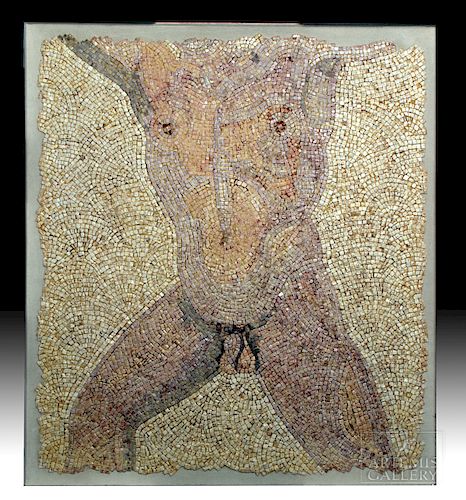Roman Stone Mosaic - Nude Male Torso of Hero or Athlete
Lot 78
About Seller
Artemis Gallery
686 S Taylor Ave, Ste 106
Louisville, CO 80027
United States
Selling antiquities, ancient and ethnographic art online since 1993, Artemis Gallery specializes in Classical Antiquities (Egyptian, Greek, Roman, Near Eastern), Asian, Pre-Columbian, African / Tribal / Oceanographic art. Our extensive inventory includes pottery, stone, metal, wood, glass and textil...Read more
Estimate:
$25,000 - $35,000
Absentee vs Live bid
Two ways to bid:
- Leave a max absentee bid and the platform will bid on your behalf up to your maximum bid during the live auction.
- Bid live during the auction and your bids will be submitted real-time to the auctioneer.
Bid Increments
| Price | Bid Increment |
|---|---|
| $0 | $25 |
| $300 | $50 |
| $1,000 | $100 |
| $2,000 | $250 |
| $5,000 | $500 |
| $10,000 | $1,000 |
| $20,000 | $2,500 |
| $50,000 | $5,000 |
| $100,000 | $10,000 |
| $200,000 | $20,000 |
About Auction
By Artemis Gallery
Feb 21, 2019
Set Reminder
2019-02-21 10:00:00
2019-02-21 10:00:00
America/New_York
Bidsquare
Bidsquare : Exceptional Antiquities, Asian, Ethnographic
https://www.bidsquare.com/auctions/artemis-gallery/exceptional-antiquities-asian-ethnographic-3858
An important one-day auction featuring museum-worthy examples of Egyptian, Greek, Roman, Etruscan, Near Eastern, Far East / Asian, Pre-Columbian, African / Tribal, Oceanic, Native American, Spanish Colonial, Russian, Fossils, Ancient Jewelry, Fine Art, so much more! Artemis Gallery info@artemisgallery.com
An important one-day auction featuring museum-worthy examples of Egyptian, Greek, Roman, Etruscan, Near Eastern, Far East / Asian, Pre-Columbian, African / Tribal, Oceanic, Native American, Spanish Colonial, Russian, Fossils, Ancient Jewelry, Fine Art, so much more! Artemis Gallery info@artemisgallery.com
- Lot Description
Roman, the Levant, late Imperial Period, ca. 3rd to 5th century CE. An incredible mosaic depicting a nude male torso, perhaps belonging to a hero or athlete given his superb physical condition. The subject is portrayed with outspread legs - no fig leaf to hide his privates - and outspread arms. The design is comprised of square stone tesserae in hues of peachy pink, sunny yellow, mauve, sienna, black, and white hues. The composition is impressive in several ways. The artist clearly went to great efforts to study anatomy and rendered the human body with naturalistic proportions, musculature, fine details, and motion. Shape, size, and color of tesserae were varied in order to create shadow and depth in the figure. Even the background is interesting, presenting repeated patterns of nested and radiating arches, concentric circles, and flowing borders surrounding the form. A magnificent piece for anyone who appreciates the male nude. Size: mosaic composition measures 29.75" W x 33.25" H (75.6 cm x 84.5 cm); 31.125" W x 35.25" H (79.1 cm x 89.5 cm) including matrix and metal framing
Mosaics (opus tesellatum) are some of our most enduring images from the Roman world, exciting not only for their aesthetic beauty, but also because they reveal what Romans chose to depict and see every day decorating their private and public spaces. Here we have a depiction of the male nude, perhaps intended for a cubiculum (bedroom) or a balmeum (bath house).
In the Roman province of Syria, which encompassed most of the ancient Near East/Levant, mosaics developed as a popular art form relatively late, with most finds coming from the 3rd century CE or later. Syria was one of Rome's wealthiest provinces, but it was also far removed from Rome itself and Roman culture was overlaid on enduring cultural traditions from Hellenistic Greece and the great civilizations that came before it. Antioch-on-the-Orontes (modern day Antakya, Turkey), was the capital of northern Roman Syria, and its excavations in the 1930s revealed more than three hundred mosaic pavements - of which many embellished public baths. Popular mosaic themes from this region were often mythological or religious scenes, depicting gods and goddesses; however, sometimes mosaics were created to fit the theme of a building or room. This example may have been intended for a bedroom or more likely, a bath house or gymnasium.
Provenance: private East Coast, USA collection; ex-private Connecticut, USA collection
All items legal to buy/sell under U.S. Statute covering cultural patrimony Code 2600, CHAPTER 14, and are guaranteed to be as described or your money back.
A Certificate of Authenticity will accompany all winning bids.
We ship worldwide and handle all shipping in-house for your convenience.
#139206Expected wear with chips, some losses, recessions, and abrasions to the surface commensurate with age. Areas of earth deposits. Set in a modern plaster matrix with a metal frame. Some stones put back when transferred from old concrete and iron frame to a lighter backing and honeycomb, but all stones are original.Condition
- Shipping Info
-
All shipping is handled in-house for your convenience. Your invoice from Artemis Gallery will include shipping calculation instructions. If in doubt, please inquire BEFORE bidding for estimated shipping costs for individual items.
-
- Buyer's Premium



 EUR
EUR CAD
CAD AUD
AUD GBP
GBP MXN
MXN HKD
HKD CNY
CNY MYR
MYR SEK
SEK SGD
SGD CHF
CHF THB
THB
















